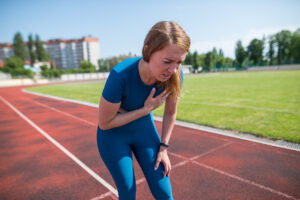This article is about sudden cardiac death in athletes. Dr. Robert A. Harrington and Dr. Manesh Patel reported from the European Society of Cardiology 2023 Congress in Amsterdam. Notably, this congress took place from August 25-28, 2023 with 30,000 participants. Another key point is that one of the important topics was sudden cardiac death in athletes. In general, you normally assume that athletes are healthy, and their hearts would support their peak athletic activities. It is important to realize as Drs. Harrington and Patel reported that under certain circumstances athletes can suddenly die.
Bronny James, a high school basketball player was rescued from a cardiac arrest as this article shows. Apparently, he has a congenital heart condition, which makes him more vulnerable to get an irregular heartbeat. It must be remembered that his can cause his heart to stop beating. Fortunately, he was revived at the Mount Sinai Hospital in New York. To clarify, there are a number of non-invasive procedures that interventional cardiologists use to correct abnormalities in a heart. Specifically, following such procedures the person’s heart is more stable.
Ventricular fibrillation
To explain, irregular heartbeats leading to ventricular fibrillation is one cause of death in athletes. Another key point, often there can be other underlying conditions that lead to this. Examples are a long QT interval on an ECG, a big thick heart (medical term: hypertrophic cardiomyopathy), and dilated aortas in tall people.
Success stories of reviving people and athletes with sudden cardiac death
In other words, over the years two methods showed success in rescuing athletes with sudden cardiac deaths. The first is CPR (cardiopulmonary resuscitation). This keeps the blood flowing and delivers oxygen to the lung capillaries. Next the emergency medical team is called in who provide an automated external defibrillator to the chest. This can revive up to 100% cases of athletes with sudden cardiac deaths. The key is to do CPR right away and to have the emergency medical team use the automated external defibrillator (AED) right away.
Screening methods to prevent sudden cardiac death in athletes
With this in mind, the medical profession has started to do preventative tests of athletes. First, Italy is one of the countries that has persistently done standard screening. Physicians order ECG’s and echocardiograms. They can readily diagnose hypertrophic cardiomyopathy with these tests. Second, a new stethoscope can get sounds and some ECG signals at the same time. This helps to diagnose several abnormal cardiac conditions.
Third, another point is that there have to be enough people around a sports event who have experience in performing CPR (cardiopulmonary resuscitation). Certainly, the sooner you start CPR, the more successful is the outcome with respect to a full recovery. Next medical personnel with the AED equipment are necessary to bring the heart rhythm back to a sinus rhythm. When the patient’s heart beats normally again, the patient needs transportation to the nearest hospital for further monitoring and stabilization.
Commotio cordis
When there is a lower chest impact from a hockey puck, baseball or lacrosse ball the heart can suddenly come to a standstill. Physicians call this commotio cordis. These athletes need immediate CPR to keep them alive followed by timely administration of an automated external defibrillator. Often the heart beats normally after this. If immediate medical help is not available, these young athletes die and it becomes an upsetting newspaper story.
Conclusion
Dr. Harrington interviewed Dr. Manesh Patel, a cardiologist from Duke University regarding sudden cardiac death in athletes. A thump to the chest from a hockey puck or a baseball can cause the heart to stop beating. In order to save this athlete from dying bystanders have to start CPR right away. This helps to continue blood circulation and brings oxygen into the tissues. Next medical personnel apply electrode pads from an automated external defibrillator (AED) to the chest wall. One or two electric shocks are administered. This often revives the heart or converts irregular heart contractions to the normal sinus beats, and the athlete recovers. The emergency medical team transports the patient to the nearest hospital for observation and further treatments. CPR and AED in combination can save up to 100% of cases that would otherwise turn into sudden cardiac deaths.






